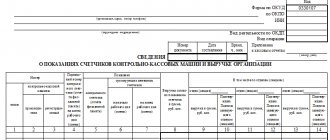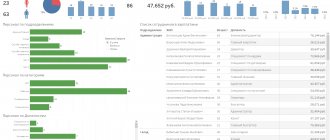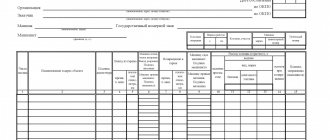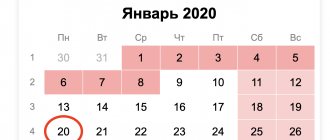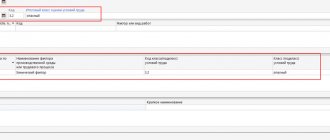Who must submit a report on Form 1-T and when?
Officials determined that only small businesses are exempt from the need to submit this statistical report. All other organizations must report to statistics.
Any organization has the opportunity to independently check whether it needs to submit this report. This can be done on the official website of Rosstat (note that the previous website address does not work; our link will take you to the current page). To do this, you must enter the OKPO, INN or OGRN of the organization. If you still need to take it, you should do it before January 21, 2020. After this date, statistical authorities will begin to apply penalties to latecomers.
Separately, it should be noted that if an organization has separate divisions (branches), then the 1-T report is filled out and submitted both separately for each of such divisions and for the entire organization as a whole. It is important to understand that in this case, by a separate unit, officials understand any territorially separate unit from the organization, at or from the location of which economic activity is carried out at equipped stationary workplaces. Whether such a unit is registered as separate or not does not play a role in this case. The report should be submitted to the territorial statistical authorities at the location of each of them.
In addition, bankrupt organizations in respect of which bankruptcy proceedings have already been opened are not exempt from the obligation to submit this report. The legislation allows not to submit this form only after the complete liquidation of such a legal entity.
Who should report to?
Russian statistics, form 1 labor force 2020, who submits it is determined by the main type of economic activity. In most cases, Rosstat representatives send out special notifications about the need to submit a report. However, due to the huge number of economic entities falling under statistical surveillance, it is likely that the notification will not arrive.
Important! If the organization is named in the list of accountable persons, but the notification has not been received, then Form 1 labor force for 2020 will still have to be submitted. Let us remind you that for failure to provide statistical information there is a fine of up to 70,000 rubles. And the absence of an official request is not a valid reason.
https://youtu.be/LnV52e9I5tE
Sample of filling out the 1-T statistics form
Before you start filling out the document itself, you need to remember that it contains such an indicator as the average number of employees. It can be calculated using the standard formula:
The sum of the average number of employees for all months of the reporting year, divided by 12.
In this case, the average number of employees per month is calculated as follows:
The sum of the payroll number of employees for each calendar day of the month, from the 1st to the 30th or 31st (for February - on the 28th or 29th), including holidays (non-working days) and weekends, divided by the number of calendar days of the month.
Form 1-T: filling rules
Statistics require filling out this document based on data as of December 31, 2020. The title page is easy to fill out. It should have:
- full name of the organization and a short name in brackets next to it;
- legal address of the legal entity, indicating the subject of the Russian Federation and the index;
- the actual address of the organization, if it does not coincide with the legal one,
- OPKO code assigned by Rosstat.
In section 1 you should indicate the numerical values:
- the average number of employees of the organization, broken down by industry;
- the wage fund of these workers;
- social benefits fund for these employees;
- fund for payments to external part-time workers.
The number of employees must take into account all persons working on the basis of employment contracts, including those performing temporary or seasonal work, as well as the owners of the organization if they receive a salary. The average headcount traditionally does not include external part-time workers, persons with whom civil contracts have been concluded, employees on maternity leave, and employees on study leave.
New reports for employers
By order of Rosstat, annual, quarterly and monthly forms for statistical observation have been approved, which most employers will have to submit in 2020. In particular, based on the results of 2017, you will have to report in the following forms:
— No. 1-T “Information on the number and wages of employees” (Appendix No. 1);
— No. 1-T (working conditions) “Information on the state of working conditions and compensation for work with harmful and (or) dangerous working conditions” (Appendix No. 2);
— No. 2-GS (ГЗ) “Information on additional professional education of federal state civil servants and state civil servants of the constituent entities of the Russian Federation” (Appendix No. 3);
— No. 2-MS “Information on additional professional education of municipal employees” (Appendix No. 4);
— No. 1-T (GMS) “Information on the number and remuneration of employees of state bodies and local governments by personnel categories” (Appendix No. 5);
— No. 3-F “Information on overdue wages” (Appendix No. 6).
In 2020, every month employers will have to send the following reports to the territorial bodies of Rosstat:
— No. 1-Z “Labour Force Sample Survey Questionnaire” (Appendix No. 7);
— No. P-4 “Information on the number and wages of employees” (Appendix No. 8);
— No. 1-PR “Information on the suspension (strike) and resumption of work of labor collectives” (Appendix No. 9).
For the first quarter of 2020, you will need to submit Form No. P-4 (NZ) “Information on underemployment and movement of workers” to the statistical authorities (Appendix No. 10). The deadlines for submitting each report are stated directly in the forms themselves, as well as the procedure for filling them out. In addition, by the same order of Rosstat the following were declared invalid:
1. Appendix No. 10 “Form of federal statistical observation
2. No. 1-PR “Information on the suspension (strike) and resumption of work of labor collectives,” approved by Rosstat order No. 357 dated August 3, 2020;
3. Order of Rosstat dated August 2, 2020 No. 379 “On approval of statistical tools for organizing federal statistical monitoring of the number, conditions and remuneration of workers, activities in the field of education”;
4. Order of Rosstat dated March 9, 2020 No. 165 “On approval of the federal statistical observation form “Labour Force Sample Survey Questionnaire”. Let us remind you that you can find out what forms of statistical reporting your organization needs to submit on the official website of Rosstat using
Statistical reporting is one way to centralize information about the activities of companies and entrepreneurs. To disclose and systematize information on wages and headcount, the 1T statistical form is used. Let's look at what Form 1-T (statistics) is and a sample for filling out this document.
Self-test
In order to check the correctness of its completion, department specialists prepared control ratios. They are shown in the table:
| No. | Data control |
| 1 | sum of lines from 02 to 13 = line 01 in columns 4, 5, 6, 7 |
| 2 | line 14 column 4 and 6 = 0 |
| 3 | line 15 = sum of lines 01 and 14 in columns 4, 5, 6, 7 |
| 4 | line 14 <= line 15 according to columns 5 and 7 |
| 5 | line 01 <= line 15 in columns 5 and 7 |
Annual reports to Rosstat in 2020
| Report form | Deadline |
| No. 1-T “Information on the number and wages of employees” (Rosstat order No. 485 dated 06.08.2018) | |
| No. 7-injuries “Information on injuries at work and occupational diseases” (Rosstat order No. 417 dated June 21, 2017) | |
| No. 1-enterprise “Basic information about the activities of the organization” (Order of Rosstat dated July 27, 2018 N 461) | |
| “Information on the use of funds” (Rosstat order No. 468 dated July 31, 2018) | |
| “Information on wages of employees by profession and position” (Rosstat order No. 430 dated June 26, 2017) | |
Quarterly reports to Rosstat in 2020 | |
| Report form | Deadline |
| “Information on underemployment and movement of workers” (Rosstat order No. 485 dated 06.08.2018) | No later than the 8th day of the following month following the reporting period |
| “Information on the number and wages of employees (Rosstat order No. 566 dated 09/01/2017) | Until the 15th of the next month |
| No. 1-DA ((Order of Rosstat dated August 31, 2017 No. 564) | No later than the 15th day of the second month of the reporting quarter |
| “Information on investments in non-financial assets” (Rosstat order No. 462 dated July 27, 2018) | No later than the 20th day of the month following the reporting period |
| “Information on the main performance indicators of a small enterprise” (Rosstat order No. 461 dated July 27, 2018) | No later than the 29th day after the end of the quarter |
| “Basic information about the organization’s activities” (Rosstat order No. 472 dated July 31, 2018) | No later than the 30th day of the month following the quarter |
| “Information on the costs of production and sale of products (goods, works, services)” (Rosstat order No. 320 dated July 15, 2015) | On the 30th of the next month for the 1st quarter, 1st half of the year, 9 months |
Monthly reports to Rosstat | |
| Report form | Deadline |
| “Information on the production and shipment of goods and services” (Rosstat order No. 472 dated July 31, 2018) | No later than the 4th working day of the next month |
| “Information on the number and wages of employees (Rosstat order No. 485 dated 06.08.2018) | No later than the 15th of the next month |
| “Information on the financial condition of the organization” (Rosstat order No. 468 dated July 31, 2018) | No later than the 28th of the next month |
Unified system of classification and coding of economic information
Official statistics use a unified system for classifying and coding economic data. Examples are:
- Classification by economic sectors;
- Classification of types of economic activities;
- Classification of financial transactions;
- Classification of goods and services;
- Classification of liabilities and assets of an enterprise;
- Classification of taxes and other fees;
- Classification of expenses of government bodies;
- Classification of administrative forms of ownership, etc.
The main objectives of the unified classification and coding system:
- Creation of favorable conditions for the formation of a unified information environment on the territory of the Russian Federation;
- Systematization of data in accordance with unified classification rules, their application in forecasting the social and economic development of the state;
- Information support in the field of taxation, social insurance, licensing, real estate transactions, etc.;
- Promotion of cooperation and specialization in the production field;
- Streamlining the certification and standardization of manufactured goods and services provided;
- Promoting intersectoral exchange of information resources;
- Ensuring compatibility of information resources and information systems;
- Harmonization of a unified classification and coding system with regional and international standards and classifications.
Statistical reporting in 2020: what and when to submit
Reports to statistics for 2020, when and which ones to submit, can be clarified at the territorial statistics department or check the composition of statistical reports on.
Statistical reporting is provided for any business entity, regardless of the type of their activity.
Russian statistics established reports for 2020, who submits them, in a separate Federal Law No. 282-FZ of November 29, 2007.
So, in accordance with Art. 6 and 8 of the law, the following are required to report:
- individual entrepreneurs.
- legal entities officially registered on the territory of the Russian Federation;
- branches and representative offices of foreign companies operating in the Russian Federation;
- state authorities, as well as local governments;
- branches, separate divisions and territorial representative offices of Russian organizations;
Economic entities that have the right to maintain simplified accounting records or not to maintain them at all, as well as taxpayers using simplified taxation systems,
What are statistics codes for?
You will need knowledge of statistics codes in the following cases:
- opening a bank account;
- submission of tax and accounting reports;
- filling out payment orders and payment receipts;
- submission of statistical reporting (Gosstat);
- carrying out export-import operations;
- changing the place of registration of an individual entrepreneur or the location of an organization (legal address);
- when opening a branch of the organization;
- changing the full name of the individual entrepreneur or the name of the legal entity;



